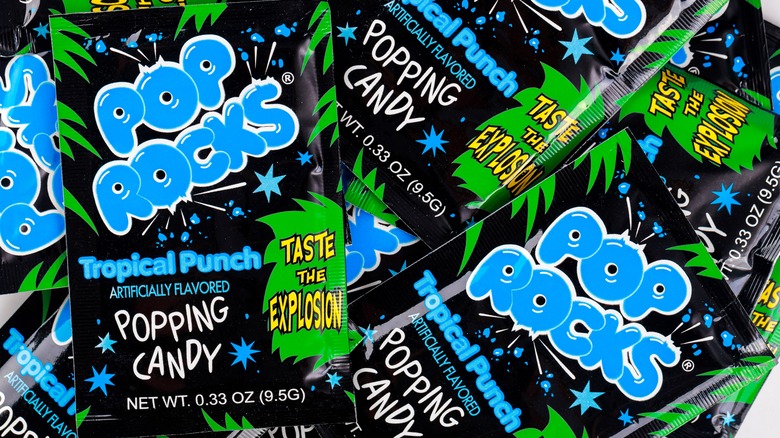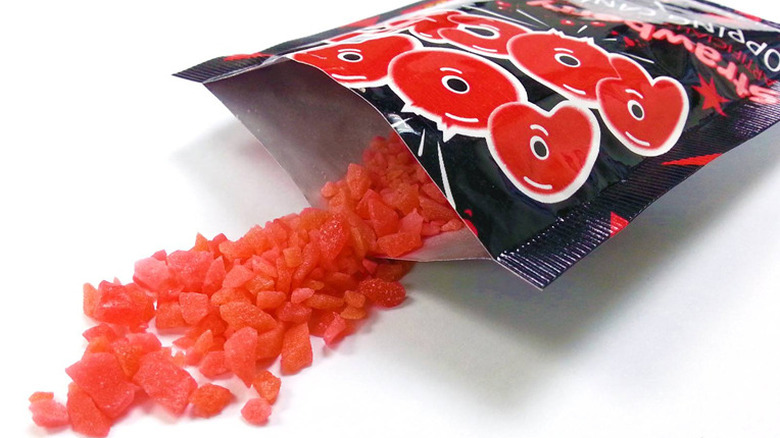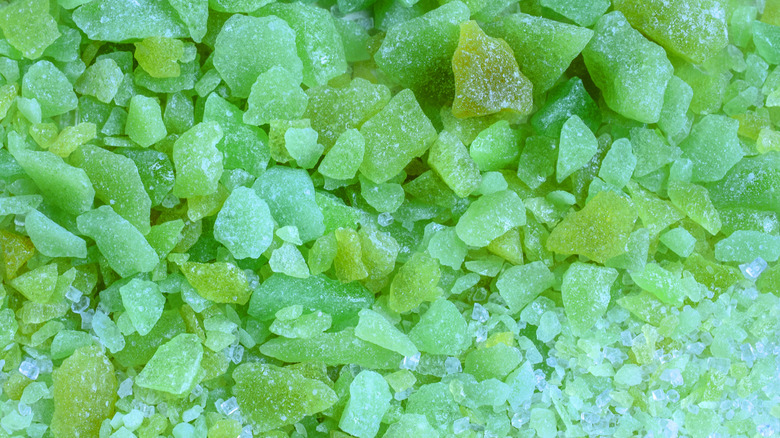Can You Eat Too Many Pop Rocks?
Despite being a popular candy for over four decades, Pop Rocks have been plagued by doubts about safety for almost as long. The popping candy is perfectly harmless, but that hasn't stopped rumors about its dangers from persisting to this day.
Pop Rocks were a sensation when first released in the late 70s. When the gasified sugary nuggets come into contact with moisture, like saliva in your mouth, or a beverage, carbon dioxide trapped inside is released, causing a fizzing reaction most people experience as a fun sensation on the tongue, akin to drinking bubbly soda pop — and just as innocuous. Regardless, myths that have sprung up concerning the supposed hazards of Pop Rocks abound.
The most enduring of these is that eating too many Pop Rocks will cause your stomach to explode. Dovetailing with busted myths about soda, the "exploding kid" tale involves a boy who drank soda and then ate Pop Rocks (or vice versa), causing his stomach to burst. This developed into an urban legend involving child actor John Gilchrist, known for playing Little Mikey in the 1970s Life cereal "He likes it! Hey Mikey!" commercials. The story goes that Gilchrist drank a six-pack of soda followed by six pouches of Pop Rocks, which ended up killing him. The truth is that this never happened; the actor is still alive and well — and you simply cannot eat too many Pop Rocks to the point of rupturing your internal organs — nor will eating them with soda harm you.
The explosive history of popping candy
Chemist William A. Mitchell created the Pop Rocks prototype in 1956 while developing an instant soda for General Foods (now Kraft). The idea was to make a tablet of self-carbonating soda that would activate when combined with liquid. The experiment was initially unsuccessful and shelved — although among Mitchell's other notable and beloved inventions are Cool Whip, Tang, and Jell-O. His research wasn't revisited until 20 years later when, in 1976, it was reformulated as carbonated candy, and Pop Rocks as we now know them were born.
Even though Pop Rocks were proven to pose no inherent risk, by 1979, the rumors and alarm over the product had swelled to an all-out panic, causing the FDA to set up a hotline to assuage the concerns of parents who feared that Pop Rocks would kill their children. General Foods went on a public relations blitz in an attempt to educate and assure the general public that Pop Rocks were safe; the company took out ads in national publications and sent letters to schools, and yet the scuttlebutt continued unabated. Pop Rocks were discontinued in 1983, which only fanned the flames of false stories about the candy being deadly. General Foods, however, maintained that the reason for pulling the plug was low sales, blamed on the product's short shelf-life. By 1986, Pop Rocks were back on the market — and the brand is now owned by the Spanish company Zeta Espacial and is produced in Atlanta, Georgia.
Science proves Pop Rocks are totally safe
Pop Rocks' main ingredients are sugar, lactose, and corn syrup. What causes their namesake pop is carbon dioxide, the same gas used to carbonate soda. It is essentially shattered hard candy, which — through a process of heating, pressurizing, and cooling — is pumped full of carbon dioxide bubbles. When the tasty, fruit-flavored pellets mix with moisture in your mouth, the bubbles pop, setting off tiny blasts of gas and crackling sugar.
It's this fizzy business that's the possible culprit of the Pop Rocks rumors, stemming from the mistaken belief that what causes the candy's fizz is an acid-plus-base reaction, like when vinegar and baking soda mix and cause a big, foamy eruption. That is not where Pop Rocks get their effervescence from at all; the bubbly effect is caused entirely by carbon dioxide, which is safe to consume (per the FDA).
In fact, there is less carbon dioxide in one pouch of Pop Rocks than there is in half a can of cola, an amount that cannot hurt anyone, even if eaten in vast quantities together with soda. According to Pop Rocks' website, the worst that can happen from ingesting Pop Rocks is "a hearty, non-life-threatening belch." Mythbusters proved this on their first episode in 2003 when they filled a pig's extracted stomach with the equivalent amount of soda and Pop Rocks said to have killed Little Mikey, with the only result being that the stomach swelled in volume before releasing a posthumous porcine burp.



